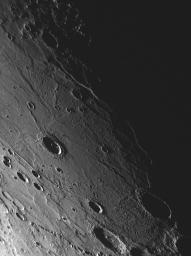
|
MESSENGER Discovers an Unusual Large Basin on Mercury
- Click the image above for a larger view
- Full-Res JPEG (763 x 1024) (93.0 kB)
- Full-Res TIFF (763 x 1024) (782.4 kB)
Caption:
This NAC image shows a view of the interior of a newly discovered large impact basin on Mercury, with a diameter of roughly 700 kilometers (430 miles). The basin was imaged as MESSENGER approached Mercury for the mission's second flyby of the innermost planet and was visible even on the optical navigation images (see PIA11244 ). However, the high-resolution NAC images acquired as the spacecraft was closer to Mercury revealed unusual features associated with this basin. As seen in this NAC image, the basin floor has a set of radiating fractures that bear a similarity to the extensional troughs of Pantheon Fossae , imaged near the center of Caloris basin during MESSENGER's first Mercury flyby. The neighboring terrain to the left of this image, which can be viewed in a previously released NAC image (see PIA11248 ), shows a long scarp within this basin. Members of the MESSENGER Science Team are currently mapping the features associated with this unusual basin and investigating the history of its formation and modification.
Date Acquired:
October 6, 2008
Image Mission Elapsed Time (MET):
131766401
Instrument:
Narrow Angle Camera (NAC) of the Mercury Dual Imaging System (MDIS)
Resolution:
30 meters/pixel (0.27 miles/pixel) near the top of the image
Scale:
The top of this image is about 330 kilometers (210 miles) across
Spacecraft Altitude:
16,800 kilometers (10,400 miles)
Background Info:
These images are from MESSENGER, a NASA Discovery mission to conduct the first orbital study of the innermost planet, Mercury. For information regarding the use of images, see the MESSENGER image use policy .
Cataloging Keywords:
| Name | Value | Additional Values |
|---|---|---|
| Target | Mercury | |
| System | ||
| Target Type | Planet | |
| Mission | MESSENGER | |
| Instrument Host | MESSENGER | |
| Host Type | Orbiter | |
| Instrument | Mercury Dual Imaging System (MDIS) | |
| Detector | Narrow Angle Camera (NAC) | |
| Extra Keywords | Grayscale, Impact | |
| Acquisition Date | ||
| Release Date | 2008-12-15 | |
| Date in Caption | 2008-10-06 | |
| Image Credit | NASA/Johns Hopkins University Applied Physics Laboratory/Carnegie Institution of Washington | |
| Source | photojournal.jpl.nasa.gov/catalog/PIA11769 | |
| Identifier | PIA11769 | |
